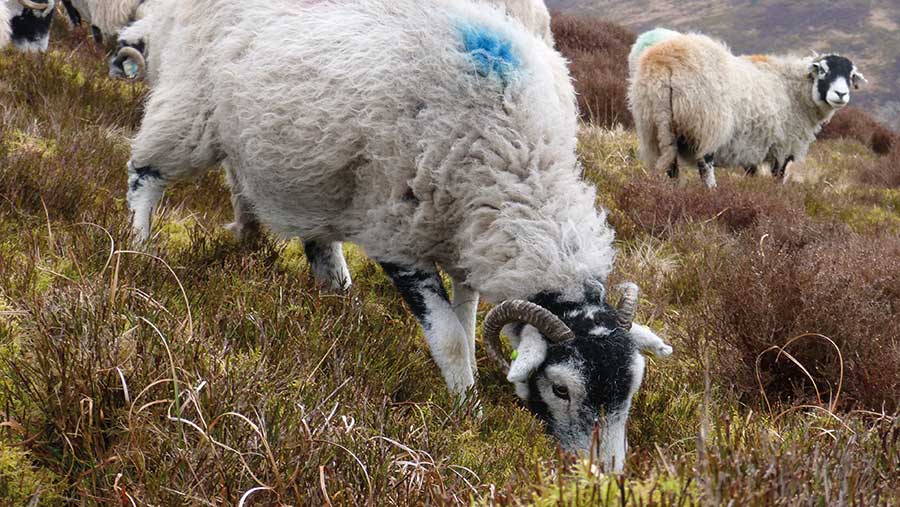Hill sector shrinks as lowland flocks self-replace
 © MAG/Michael Priestley
© MAG/Michael Priestley Traditional stratified sheep breeding has lost more market share as lowland farmers close flocks and try cross-bred and composite breeds.
Latest estimates suggest Scottish Blackface numbers have reduced by 36% since 2012, with Welsh Mountain, Beulah, Welsh Hill Specked Face and Swaledale all back 15-19%.
However, the Cheviot breed showed a trend-bucking growth of 4%.
This is according to the 2020 Sheep Breed Survey, which underlined an increase in Aberfields (and other Innovis sires), wool-shedding breeds (Easycare and Exlana) and Lleyns.
See also: Hill farms slow to market but snapped up by investors
Industry figures said the data reveals the effect tree planting and agri-environment schemes have had on upland sheep numbers.
Geoff Pollott of the Royal Veterinary College, and Samuel Boon, senior manager at Signet, discussed the key findings on an AHDB webinar. These include:
- Cross-bred rams are being used more widely – possibly because of their longevity, hybrid vigour and a good balance of traits
- Wool-shedding types have grown in popularity – wool prices are low and cost of production is a factor
- Texels have increased in cross-bred ram and dam lines
- Lleyns have continued to gain ground, partly owing to maternal traits, efficiency and an ability to produce a lot of carcass weight in relation to mature ewe size.
What is the sheep breed survey?
- This is the sixth sheep breed survey – the first was in 1971
- It captures the trends and breeds of UK sheep production
- Data returned covered 16% of breeders or 11% of breeding ewes
- Data is checked against Defra flock size and regional distribution
- Estimates are based on the sample
- Jointly funded by the AHDB, QMS and HCC
Decline of stratification
Dr Pollott said the number of purebred hill sheep had fallen by 600,000 head, with fewer bred to crossing and terminal sires.
“In 2012, the ratio of traditional to lowland [sheep] was 55:45, now it’s 51:49. Back in 1971, 85% of the sheep were in a traditional cross-breeding structure,” he said.
Changing role of uplands
National Sheep Association chief executive Phil Stocker said changes to support payments with Environmental Land Management and the Basic Payment Scheme have forced commercial sheep farmers to shut out disease so their businesses could be “leaner and meaner”.
Mr Stocker said: “The Mule breeds definitely bring something; they are milky, have good uniformity of lamb production and your options for choosing sires are many and varied. However, what this survey shows is the interest in farmers taking control of their own genetics. There is a fear of buying in things you don’t want, whether it be resistant worms or iceberg diseases.
“Mule associations are aware of this and it’s pushing them to try new things. I don’t see this as the end of stratification at all.”
He said hill sheep breeding increasingly looked like it had two directions of travel: a traditional way that embraces diversification and adds value, or a route that requires more focus on health status accreditation.
Mr Stocker added Defra’s Animal Health and Welfare Pathway was a likely future aid for farmers looking at health status and blood testing.
Mules making changes
Mule Group chairman and sheep breeder Derek Hall, Firth flock, Penicuik, said Mule breeders were improving health status, marketing and communication.
“Health status is a big thing,” said Mr Hall. “Some markets are now putting health status in catalogues at ewe lamb sales.”
He acknowledged how threatening ovine pulmonary adenocarcinoma, maedi visna, Johne’s disease and other health issues could be if not monitored.
“We also need to make more use of social media on how to manage Mules. They will milk very hard, so early weaning is important for getting sheep back in-lamb.
“Communication can help bridge the gap through the dealers and get feedback going between high-health-status sheep breeders and the lowland farmers wanting to do a better job.
“There are high-health-status Mule breeders. I want to see commercial lowland farmers use these breeders instead of buying into another breed.”
